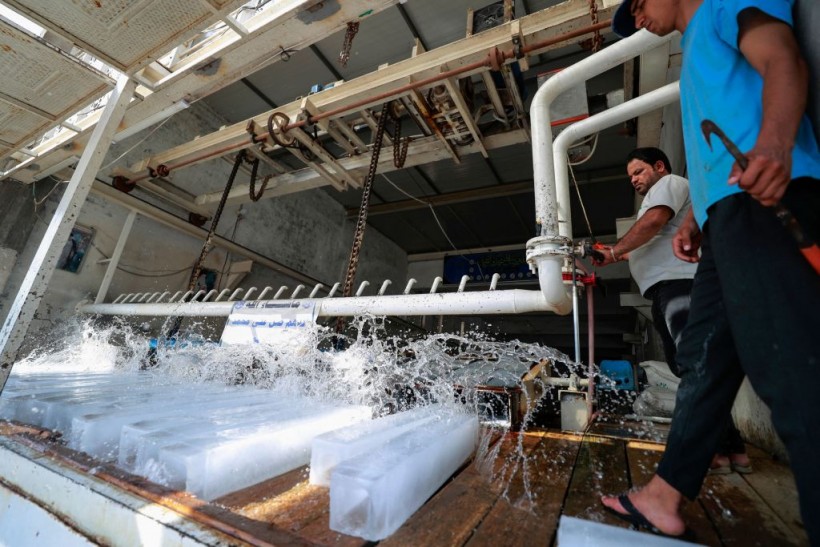Cefazolin is a widely used antibiotic that can treat various bacterial infections and prevent complications after surgery.
It is one of the essential medicines listed by the World Health Organization (WHO), which means that it is important for human health and should be available and affordable for everyone.
However, cefazolin is usually produced by a conventional method called batch manufacturing, which has several drawbacks and limitations.
This article, will explain how a new method called continuous-flow manufacturing can overcome these challenges and improve the production of cefazolin.
What is batch manufacturing and what are its problems?
 (Photo : AHMAD AL-RUBAYE/AFP via Getty Images)
(Photo : AHMAD AL-RUBAYE/AFP via Getty Images)

Batch manufacturing is a process that involves making a product in discrete steps, each of which requires a separate reactor or vessel, as per Phys.org.
For example, to make cefazolin, the raw materials have to be mixed, heated, cooled, filtered, purified, and crystallized in different containers.
Each step has to be carefully controlled and monitored to ensure the quality and safety of the product. After each batch is completed, the equipment has to be cleaned and prepared for the next batch.
Batch manufacturing has some advantages, such as high precision and flexibility in changing the product specifications. However, it also has many disadvantages, such as:
- It is time-consuming and labor-intensive, as each step takes a long time and requires human intervention.
- It is wasteful and costly, as it consumes a lot of energy, water, solvents, and materials, and generates a lot of waste and emissions.
- It is inefficient and inflexible, as it has low productivity, high inventory, and limited scalability.
- It is risky and unreliable, as it is prone to errors, contamination, and accidents.
These problems make batch manufacturing unsuitable for meeting the increasing demand for cefazolin, especially in developing countries where access to this antibiotic is limited.
Moreover, batch manufacturing can cause shortages or surpluses of cefazolin, depending on the market fluctuations and the production capacity.
Also Rad: The Importance of Automation In Manufacturing For the Environment
What is continuous-flow manufacturing and what are its benefits?
Continuous-flow manufacturing is a process that involves making a product in a single reactor or vessel, where the raw materials are continuously fed in one end and the product is continuously collected from the other end, as per The University of Tokyo.
For example, to make cefazolin by continuous-flow manufacturing, the raw materials are mixed in a tube-like reactor that has a heating element inside.
The mixture flows through the reactor at a constant rate and temperature, undergoing chemical reactions along the way.
The product then flows out of the reactor into a separator that removes any impurities or by-products. The product can then be crystallized or packaged as needed.
Continuous-flow manufacturing has some challenges, such as designing and optimizing the reactor and the reaction conditions. However, it also has many advantages, such as:
- It is fast and simple, as each step takes only minutes or seconds and requires minimal human intervention.
- It is economical and eco-friendly, as it consumes less energy, water, solvents, and materials, and generates less waste and emissions.
- It is efficient and flexible, with high productivity, low inventory, and high scalability.
- It is safe and reliable, as it reduces errors, contamination, and accidents.
These benefits make continuous-flow manufacturing more suitable for meeting the varying demand for cefazolin, especially in remote or resource-limited areas where access to this antibiotic is critical.
Moreover, continuous-flow manufacturing can enable more customized and personalized production of cefazolin, depending on the needs of different patients or regions.
How did researchers achieve continuous-flow manufacturing of cefazolin?
Researchers from the University of Tokyo have recently developed a method to produce cefazolin by continuous-flow manufacturing for the first time.
They used a novel reactor that consists of a stainless steel tube with an inner diameter of 1 mm (0.04 inches) and a length of 10 m (33 feet).
The tube has an electric heating wire wrapped around it that can heat up to 300 °C (572 °F). The researchers also designed a special catalyst that can speed up the chemical reactions inside the tube.
The researchers tested their method by feeding a mixture of raw materials into one end of the tube at a flow rate of 0.5 ml (0.02 ounces) per minute.
The mixture was heated to 250 °C (482 °F) inside the tube for about 20 minutes. The product then came out of the other end of the tube at a yield of 80% (meaning that 80% of the raw materials were converted into cefazolin). The product was then purified by filtration and crystallization.
The researchers compared their method with the conventional batch method and found that their method was superior in terms of cost, time, waste reduction, energy consumption, environmental impact, safety performance.
They also found that their method could produce cefazolin with high purity (>99%) and quality, meeting the standards of the pharmaceutical industry.
The researchers hoped that their method can pave the way for more widespread and accessible production of cefazolin, as well as other essential drugs, by continuous-flow manufacturing.
They also hoped that their method can inspire more innovation and collaboration in the field of chemical engineering and drug development.
Related article: What is Casting Exactly in the Manufacturing Industry?
© 2024 NatureWorldNews.com All rights reserved. Do not reproduce without permission.





